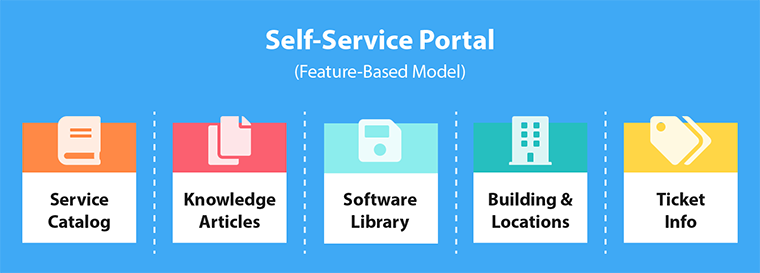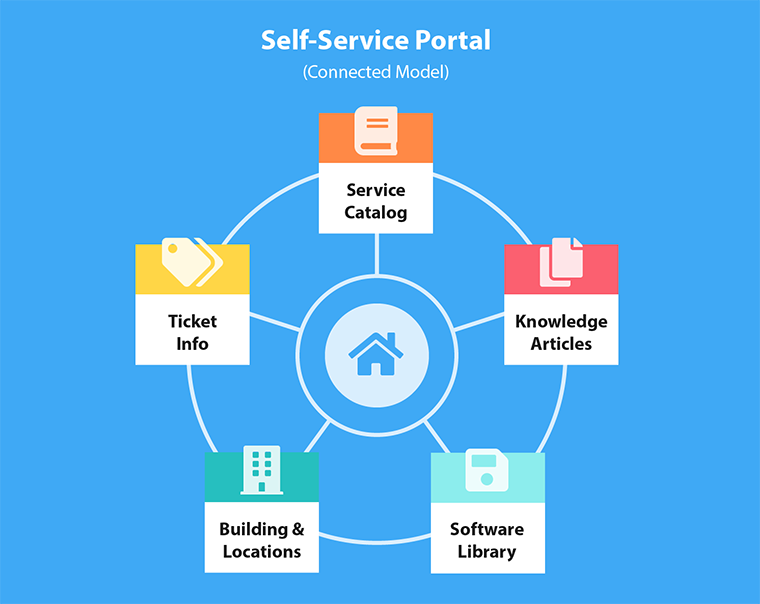Date Published May 9, 2019 - Last Updated December 17, 2019
In providing our users with self-service portals, our main goal is to shift-left and reduce support calls by putting as much information as we can out into a self-service format. In a typical self-service setup, we grow our content by releasing features. These features allow us to share our service catalogs, knowledge articles, software libraries, building/location info, and ticketing information with our end users.
As we develop out features, an issue arises. A user starts at an entry page and navigates down each feature, increasing specificity as they go. Finally, they reach the end of the road and what happens? They hit a dead end. In breaking down walls between IT and our users, we have somehow created silos.
The Feature-Based Model
The reason many of our self-service portals end up with these silos is because we start rolling out features, one by one. We listen to our user’s feedback, and we create features over time. This model allows us to share our content widely and iterate over time, but it is ultimately susceptible to the aforementioned dead ends.

Another issue with the feature-based model for self-service is that, as we extend and create feature after feature, content starts to lose context. For our users, context is an important indicator for where they are in the site and how their location relates to other content. In the image above, we display five self-service features. But a site with dozens of features or more could start to frustrate users. If a user starts their session looking at one feature, it can be difficult to find the content they need if it is encapsulated in another feature. We can mitigate issues with this model by building out a robust search tool, or by creating index pages. But, in the end, we put pressure on our users to know where the content they need is before finding it.
The Connected Model
A model that I have found to be more successful for users is the connected model. By creating relationships between all your features and content, you provide the user with an endless set of links and self-discovery. The key here is not to overwhelm the user with choices, but to provide relationships that make sense. The goal is to foster curiosity and to teach the user how content is related. By breaking down our artificial walls around content, we can empower our users to explore all of our content, in a way that feels intuitive.

As an example:
- At a University, a faculty member may want to know information about what equipment is in a classroom they are teaching in.
- The faculty member starts searching the building and location catalog and ends up finding their classroom.
- Upon reading information about the room, they see that the software library information is related to that entry, and they can view information about what software is in that classroom for teaching.
- The faculty member notices a key piece of academic software is not listed, so they are linked to a knowledge article about requesting software installation in academic spaces.
- Empowered with information, they notice a link to a service request form for requesting the software, and they can enter a ticket with their request.
- They are then linked to their ticket tracking page where they can track the status of that request.
This type of relationship sounds complex at first, but it is about enabling a better service experience for our users. When creating content, we now provide the user context for the features and show them how each individual feature complements and extends the others.
It is about enabling a better service experience for our users.

Getting Started
Having a self-service website or ITSM system that enables this type of linking through joins or relational databases is likely the most robust way to implement this. However, that approach may not always be possible. One method that many systems do allow is the plain old hyperlink. By inserting hyperlinks at the end of your existing knowledge articles, you can start to show these content relationships. The next time your articles or services are up for review, you can ask the question “What should this link to?” and use that to inform the next links to add.
By eliminating dead ends, and thinking of our content holistically, across silos, we can enable an enhanced user experience and ultimately provide a better quality of self-service. A better self-service experience makes your portal something your users will want to use, and should, ultimately, help you shift-left and reduce costly tickets down the line.
Chris Chagnon is an ITSM application and web developer who designs, develops, and maintains award-winning experiences for managing and carrying out the ITSM process. Chris has a Master of Science in Information Technology, and a bachelor’s degree in Visual Communications. In addition, Chris is a PhD Candidate studying Information Systems with a focus on user and service experience. As one of HDI’s Top 25 Thought Leaders, Chris speaks nationally about the future of ITSM, practical applications of artificial intelligence and machine learning, gamification, continual service improvement, and customer service/experience. Follow Chris on Twitter
@Chagn0n
.